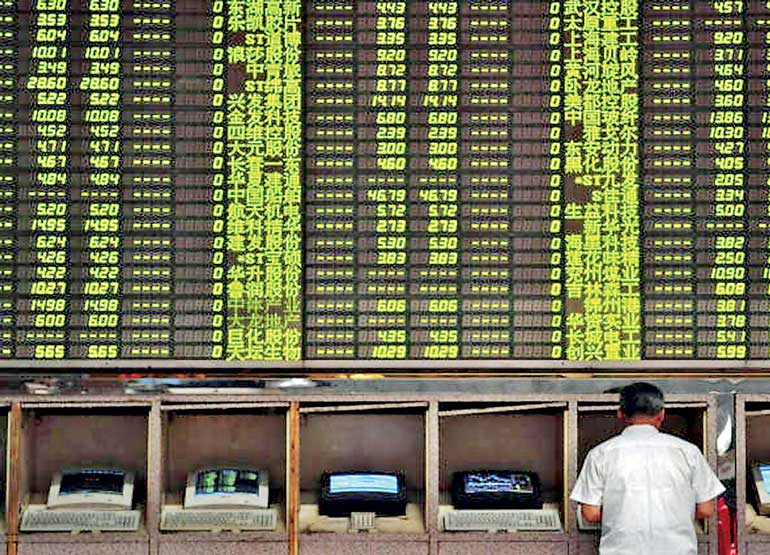Friday Dec 12, 2025
Friday Dec 12, 2025
Tuesday, 13 February 2018 00:00 - - {{hitsCtrl.values.hits}}

Sydney (Reuters): Asian share markets found a semblance of calm yesterday as S&P futures extended their bounce, though global investors were still fretting about the risks from looming US inflation data after last week’s sharp sell-off.
MSCI’s broadest index of Asia-Pacific shares outside Japan crept up 1%, having suffered a 7.3% drubbing last week. Both South Korea and China gained 1.2%, while Japan’s Nikkei was closed for a holiday.
E-Mini futures for the S&P 500 rose 0.6%, adding to a late bounce on 9 February. European bourses were expected to open with solid gains, with futures for the London FTSE already up 1.4%.
Yet a relatively sharp 14-tick drop in Treasury bond futures suggested it was too early to sound an all-clear on volatility.
“A massive build-up in market leverage has been partially unwound in the blink of an eye and morphed into something far more broad-based,” said Chris Weston, chief market strategist at broker IG. “One could argue that it is the US bond market that is the driving force, and will remain so through this coming week.”
Particularly challenging will be US consumer price data on Wednesday given that it was fears of faster inflation, and thus more aggressive rate rises, that triggered the global rout in the first place.
Median forecasts are for consumer price inflation to slow a little to 1.9% in January from a year earlier, mainly due to the base effect of a high reading in January 2017, while the core measure is seen ticking down to 1.7%.
A result in line with or below expectations would likely be a big relief, while anything higher could well spook investors, lift bond yields and batter stocks.
Barclays economist Aziz Sunderji suspects the inflation scare will prove to be transitory. “Tight jobs markets will pressure wages upwards, but technology, automation, and globalisation are important – and slow moving – forces acting in the opposite direction,” Sunderji argued in a note to clients. “Paradigms don’t shift on a dime. In our view, the recent market turmoil is a bump in the road, not a wholesale change of direction.”
But what a bump it was. The benchmark S&P 500 fell 5.2% last week, its biggest decline since January 2016. Ninety-six S&P 500 stocks were down 20% or more from their one-year highs, according to Thomson Reuters data.
In Asia, Hong Kong’s high-flying shares shed almost 10% for the week, while Japan lost 8.1% and South Korea 6.4%. The pivotal gauge of S&P 500 volatility, the VIX, remained relatively elevated at 29%.
Yields on US 10-year Treasury paper touched a four-year top of 2.885%, moving ever further above the S&P 500’s dividend yield of 2.34%. The ascent of yields had offered some support to the US dollar last week, but was proving of limited help yesterday as speculators returned to short the currency.
The euro clawed back 0.5% to $ 1.2288, after losing 1.8% last week, while the dollar eased 0.4% on a basket of currencies to stand at 90.118.
The dollar was steady on the yen at 108.71, aided in part by reports that Haruhiko Kuroda would be re-appointed as head of the Bank of Japan and likely would continue the country’s ultra-loose monetary policy. Commodities pared recent losses, with gold 0.6% firmer at $ 1,323.88 an ounce and off a five-week low of $ 1,306.81.
London (Reuters): Oil rose 2% yesterday, recovering some of last week’s steep losses as global equities steadied after their largest one-week slide in two years.
Brent crude futures rose 95 cents to $ 63.74 a barrel by 1012 GMT, up nearly 2%, while US West Texas Intermediate futures gained $1.03 to $ 60.23, up 1.8%.
A weaker dollar helped to boost oil by making dollar-priced crude cheaper for holders of other currencies.
Consumption remains robust, even though rising US crude production has knocked oil off its 2018 highs above $ 70 and threatened the efforts of the Organisation of the Petroleum Exporting Countries to prop up prices by reining in supply.
“Demand growth is very strong and with declines in places like Venezuela, is helping the situation. If demand stays strong, it still looks like OPEC will be in control in 2019,” SEB Chief Commodities Strategist Bjarne Schieldrop said.
“If global growth does slow down and oil demand starts to slow, then production growth in the US becomes a problem, because OPEC’s cake starts to shrink and that will be the line in the sand,” he said.
US oil production has risen above 10 million barrels per day (bpd), overtaking top exporter Saudi Arabia and coming within reach of top producer Russia.
OPEC and partners including Russia have agreed to cut their crude output by 1.8 million bpd for a second year, but US production looks set to continue to grow.
US energy companies added 26 oil rigs looking for new production last week, boosting the count to 791, the highest since April 2015, energy services firm Baker Hughes said on 9 February.